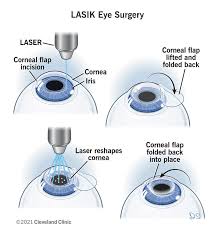 A laser ablates the corneal stroma and a hinged flap is created with a keratome.
A laser ablates the corneal stroma and a hinged flap is created with a keratome.
Has become treatment of choice for many patients with refractory errors such as myopia, hyperopia,and astigmatism.
About 750,000 procedures annually.
95.4% of patients satisfied with results of the procedure.
Complication includes flap dislocation injury.
With astigmatism it reshapes the cornea into a more symmetrical, spherical shape.
Presbyopia not be reversed with Lasik.
In the initial 24 hours after surgery, flap dislocation can occur as a result of mechanical disruption.
The process takes less than 15 minutes, does not require general anesthesia, stitches, or bandaging.
Flat dislocation is uncommon, but may be encountered even years after procedure.
Corneal ectasia is a rare but serious complication where the cornea thins and bulges outward, causing distorted vision.
It is more likely to occur in patients with pre-existing weak corneas.
Rarely, infections can occur after LASIK surgery.
Corneal perforation is an extremely rare complication that can occur if the laser accidentally cuts too deeply into the cornea.
A rare but serious complication is the Loss of Best-Corrected Visual Acuity (BCVA):
While all these complications can occur, they are relatively rare and most patients have successful outcomes with LASIK surgery.
Within 95% of patients are satisfied with the outcome of the surgery.
